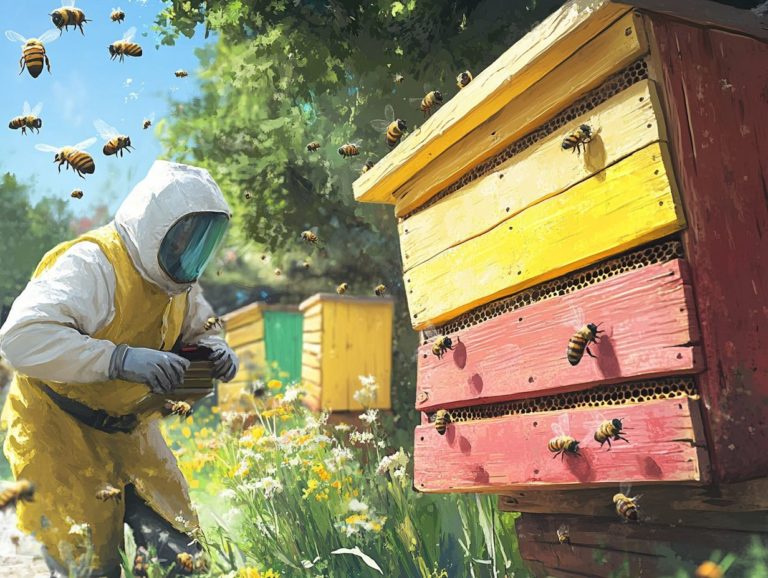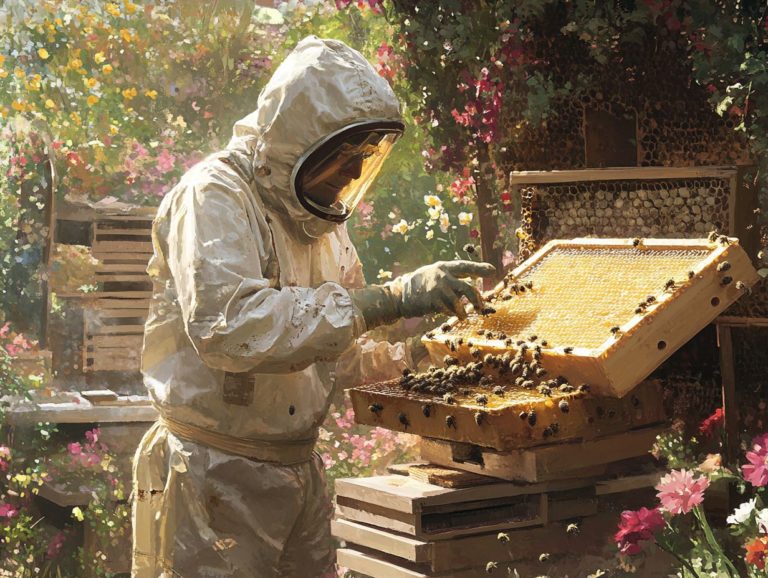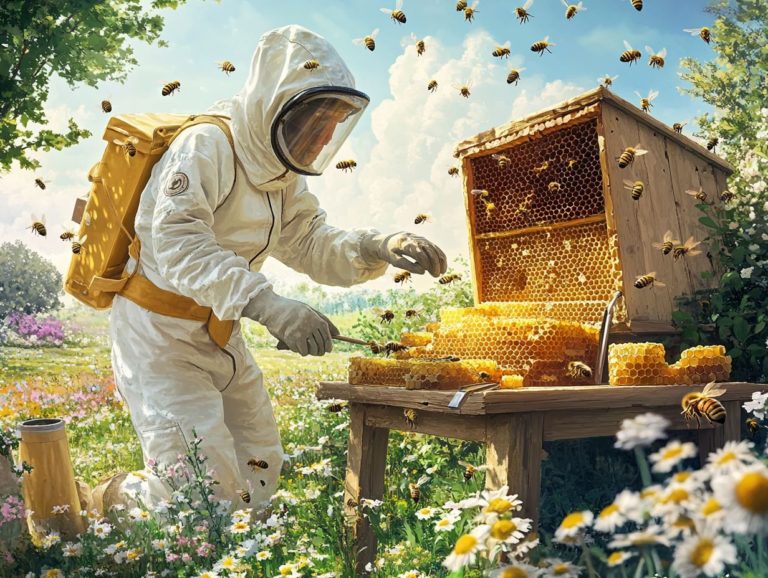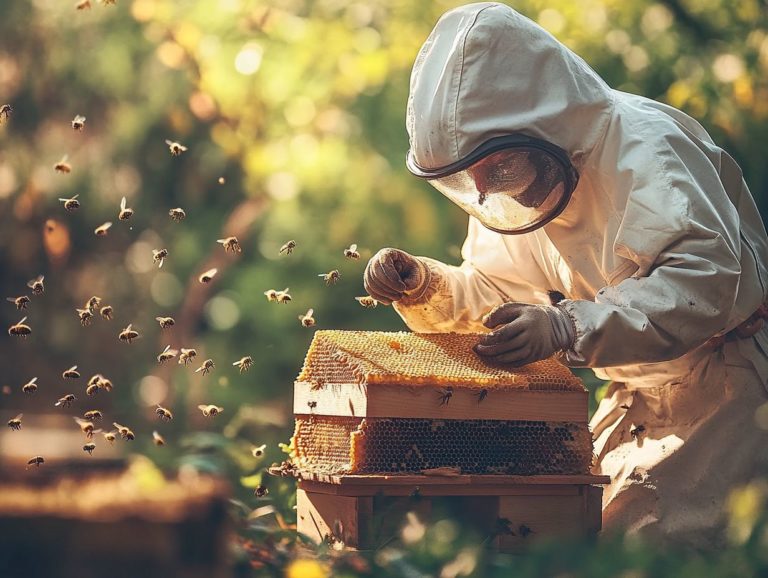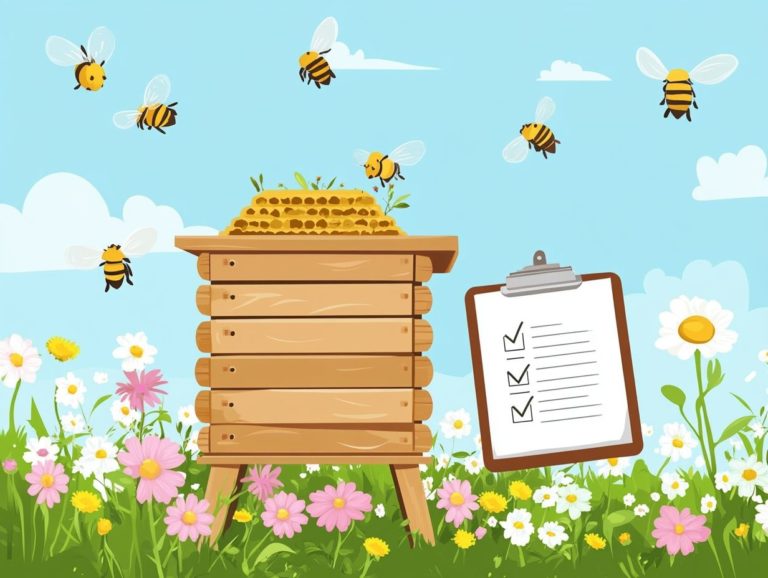Managing Hive Resources Efficiently
Efficiently managing your hive resources is essential if you want to maintain healthy colonies and maximize your honey production, which are key elements of successful beekeeping.
This article delves into the key resources involved in hive management, including bees, honey, pollen, and beyond. It offers practical strategies for effective resource management, emphasizing the importance of regular hive inspections, proper feeding techniques, and disease prevention.
You ll also discover the potential consequences of neglecting these practices, such as diminished honey yields, weakened colonies, and increased vulnerability to hive pests like the varroa mite and small hive beetle.
Regardless of whether you re a seasoned beekeeper or just beginning your journey, understanding these elements can profoundly impact your success in beekeeping operations and hive management.
Contents
- Key Takeaways:
- Why is it Important to Manage Hive Resources Efficiently?
- What are the Key Resources in Hive Management?
- How to Efficiently Manage Hive Resources?
- What are the Consequences of Inefficient Hive Resource Management?
- Frequently Asked Questions
- Wondering how to manage Hive resources efficiently?
- Why is it important to manage Hive resources efficiently in an APIARY environment?
- What are some common strategies for managing Hive resources efficiently?
- How can I monitor resource usage in Hive?
- What are some potential challenges when managing Hive resources efficiently?
- Are there any third-party tools or solutions for managing Hive resources efficiently?
Key Takeaways:
Why is it Important to Manage Hive Resources Efficiently?
Efficient hive resource management is paramount for the success of your beekeeping operations, significantly influencing the health of your honey bee colonies, their honey production, and the sustainability of your hive products. Effective beehive management practices also play a crucial role in pollination and the production tracking of hive products.
By adopting effective management practices, you can ensure that your bees thrive, remaining robust against environmental challenges and stressors such as pesticide exposure and climate change.
Additionally, utilizing resources like nutritional supplements, pest control measures, hive inspections monitoring, and conducting regular hive inspections is essential to maintain optimal conditions and support your honey bees in their natural habitat.
What are the Key Resources in Hive Management?
In your journey of effective hive management, grasping the key resources is vital for nurturing healthy colonies and amplifying honey production. The primary resources you ll need to consider include bees, honey, pollen, propolis, beeswax, water, and the space within the hive, along with resource allocation for optimal hive maintenance.
Each of these elements plays a crucial role in sustaining the delicate ecosystem of the hive. By recognizing the unique contributions of each resource, you can ensure that your beekeeping operations thrive. Careful monitoring and management of these essentials will give the power to you to maintain optimal hive health and maximize your honey yield.
1. Bees
The bees are undoubtedly the cornerstone of hive management, serving as the backbone of any thriving beekeeping venture while having a direct impact on bee health, honey bee productivity, and overall hive maintenance.
Within the colony, the queen assumes a vital role as the sole egg-laying female, ensuring that the hive s population continuously flourishes. Worker bees, the lifeblood of the colony, undertake a variety of responsibilities, from foraging for nectar and pollen to nurturing the brood and maintaining the hive’s cleanliness. Drones, with their singular purpose, focus solely on mating with the queen. Each type of bee plays an critical role in the colony’s function, and keeping a close eye on their health is crucial for optimizing honey production and pollination services.
By implementing effective management practices, such as regular hive inspections and diligent pest control, you can ensure the vitality of the hive, ultimately leading to a more robust honey yield and the sustainability of the bee population.
2. Honey
Honey stands as the cornerstone of beekeeping, serving not only as a primary product but also as a crucial resource for the sustenance of the hive. Effective hive management practices ensure sustainable honey production and hive products.
The journey of honey production begins when bees gather nectar from various flowers, a sweet liquid brimming with sugars and nutrients. As they transport this nectar back to the hive, they engage in a remarkable process of digesting and regurgitating. This transforms complex sugars into simpler forms, making honey both easily digestible and energy-rich. This process is essential for successful beekeeping.
This golden elixir is not merely a food source; it also offers essential vitamins, minerals, and antioxidants, enriching human diets with its nutritional benefits. It is important to manage pesticide resources to ensure the purity and quality of honey.
Harvesting honey requires a delicate balance to prioritize bee welfare and colony health. By following best practices such as ensuring enough honey remains for the bees sustenance you can achieve sustainable beekeeping while enhancing your profitability. Understanding honey production can help you create a thriving bee colony and enjoy the rewards of your hard work!
Supporting honey bees is crucial to protect our ecosystem!
3. Pollen
Pollen serves as a crucial source of protein for honey bees, playing an essential role in their nutrition and overall health. This directly influences the productivity of the hive. Proper pollen management is key for successful beekeeping.
Not only does pollen deliver protein, but it also provides the fats, vitamins, and minerals necessary for the various life stages within the colony. As these bees consume pollen, they transform it into the vital nutrients needed for brood rearing. This process is essential for the growth and sustainability of the colony.
As a beekeeper, it’s important to monitor the availability of pollen in your environment. Managing these sources can directly affect the health and productivity of your colonies. To further support their nutrition, many beekeepers choose to utilize nutritional supplements like protein patties or pollen substitutes which are artificial mixtures that provide bees with nutrients when natural pollen is scarce. This ensures that their bee populations remain robust and capable of thriving, even when natural pollen sources are in short supply. Involving institutes like the Honey Bee Health Coalition and universities such as the University of Guelph’s Honey Bee Research Centre can provide valuable insights and support.
4. Propolis
Propolis, a sticky material that bees make from tree sap, acts as a natural adhesive and antimicrobial agent. It plays a vital role in the maintenance and health of the hive. This substance is crucial for maintaining hive cleanliness and preventing honey bee diseases like American Foulbrood.
This remarkable compound also seals cracks and crevices in the hive. It prevents drafts and moisture while creating a formidable barrier against diseases and pests that may threaten the colony. By fostering a healthier environment, propolis enhances the overall resilience of the hive and supports the bees immune systems.
As a beekeeper, you can harness this natural treasure by managing propolis traps within your hives. This encourages your bees to produce and store even more of this invaluable substance. Incorporating propolis into your hive management practices allows you to leverage its natural properties, enhancing the health and productivity of your colonies while reducing reliance on synthetic treatments.
5. Beeswax

Managing beeswax effectively can greatly boost your hive’s strength and productivity! Beeswax is an essential resource produced by honey bees. It plays a crucial role in hive management, primarily used for constructing honeycomb and storing hive products.
This remarkable natural substance boasts incredible structural integrity. It enables bees to create hexagonally-shaped cells that maximize space while providing robust storage for honey, pollen, and brood.
Beeswax is also vital in various beekeeping methods. It helps with the preparation of foundation sheets, which are the sheets that help bees build their honeycomb.
You can sustainably harvest this valuable material. Beekeepers often collect surplus wax during regular hive inspections.
By managing wax effectively and ensuring colonies remain healthy, you contribute to the thriving of bee populations while enjoying the benefits of this versatile product.
6. Water
Water serves as a vital resource for honey bee colonies. It plays a critical role in their hydration, hive temperature regulation, and dilution of honey for feeding the young. Effective water management is crucial for hive health.
Your access to clean and plentiful water sources profoundly impacts the overall health and productivity of these essential pollinators. As a beekeeper, you hold the key to ensuring that your hives enjoy an adequate water supply.
This can be easily achieved by thoughtfully placing shallow containers filled with fresh water near your apiary. Beekeeping resources often recommend regularly monitoring water sources to prevent contamination.
Equally important is monitoring water quality. Contaminants can seriously undermine the health of bees and their honey production capabilities. Maintain the integrity of your water sources to facilitate effective hive management and elevate honey yield.
Don t wait ensure your bees have enough water today!
7. Space
Ensuring adequate space within the hive is essential for the growth and development of honey bee colonies. It allows them the necessary room to flourish and expand as needed.
When bees have sufficient space, they can organize their activities with greater efficiency. This results in enhanced foraging and brood rearing. On the flip side, overcrowding can induce stress, leading to swarming, which is when bees leave the hive to form a new colony due to crowding, or a decline in productivity.
To address potential issues stemming from overcrowding, you can adopt various strategies. Consider adding supers during peak honey flow or adjusting hive entrances to maintain optimal temperature control.
These measures create a balanced environment that supports the bees’ natural behaviors and overall well-being. Effective management of hive space not only fosters a thriving colony but also boosts honey production.
Start monitoring your hive space today to ensure your bees thrive!
How to Efficiently Manage Hive Resources?
Efficiently managing your hive resources is essential for successful beekeeping. It calls for a systematic approach that weaves together various management practices like regular hive inspections, pest control, and disease prevention strategies.
Utilizing resources like BeeKeepPal and guidelines from institutions like the Honey Bee Research Centre at the University of Guelph, you can enhance your hive management practices. Embrace effective project management techniques to ensure seamless operations.
Implementing tailored workflows and time tracking can further elevate your hive management. This enables timely interventions and optimal resource allocation.
Collaboration tools from organizations like the University of Minnesota and Purdue University can be pivotal for improving management practices. Act now to enhance your hive s health!
In summary, focus on efficient beeswax management, provide clean water sources, ensure adequate space, and utilize effective management techniques. These steps will help to keep your honey bee colonies healthy and productive!
1. Regular Inspections
Regular hive inspections are vital for managing your bees. They help you monitor the health and productivity of your colonies.
These inspections reveal potential issues like pests or diseases. Scheduling regular checks ensures nothing slips through the cracks.
During assessments, examine the baby bees arrangement, check for a healthy queen, and ensure there s enough food. Look out for common pests like Varroa mites and diseases like American foulbrood.
Using resources from the Honey Bee Health Coalition can help you improve your pest control efforts. This proactive approach nurtures healthier colonies and boosts honey production.
2. Proper Feeding
Feeding your honey bees properly is crucial, especially when natural food is scarce. It enhances colony survival and productivity.
In early spring or late autumn, bees need extra nutrients. You may use sugar solutions, pollen substitutes, or protein supplements to strengthen them.
Start feeding in spring as bees begin to emerge. In fall, focus on ensuring they have enough stores for winter.
The method you choose, like top feeders, should cater to your colony s needs and local weather. This custom approach fosters healthy bees and successful beekeeping.
3. Maintaining a Clean Environment
A clean environment in your apiary is essential for your bees health. Follow guidelines from local institutions to keep it pristine.
Regularly check the hive for debris. Clear away fallen wax, dead bees, and leftover pollen quickly to keep pests at bay.
Removing dead bees is particularly important. Prompt disposal prevents health complications within the hive.
Regular maintenance creates a thriving bee population. Remember, cleanliness leads to higher productivity and fewer diseases!
4. Controlling Pests and Diseases

Controlling pests and diseases is essential to your hive management strategy. It directly influences the health and productivity of your honey bee colonies, especially when facing threats like varroa mites and American Foulbrood. Utilizing controlling pests methodologies recommended by the USDA and Mid-Atlantic Apiculture Research Extension Consortium can safeguard your colonies.
To protect your colonies effectively, you can implement several strategies:
- Regular monitoring for signs of infestations.
- Maintaining strong genetic stock.
- Utilizing combined methods to manage pests.
Pests such as wax moths and small hive beetles can cause significant losses if not addressed promptly. Taking preventive measures like installing screened bottom boards and ensuring proper hive ventilation is important to reduce moisture levels that contribute to disease development.
Keeping your apiary clean is vital for protecting your bees from harmful pathogens and pests.
5. Harvesting Honey Properly
Harvesting honey correctly is crucial for maximizing your honey production and promoting the health and longevity of your bee colonies. Following best practices from experts at Cornell University can be highly beneficial.
Timing is everything in this process. Ideally, you should wait until the honey is fully capped, which signifies that the moisture content is low enough to prevent fermentation. By paying attention to detail, you ensure the best quality honey.
Employing gentle techniques during extraction minimizes stress on the bees and allows them to maintain their natural behaviors. Investing in equipment like a honey extractor will significantly enhance your efficiency by extracting honey without damaging the comb.
By adhering to these best practices, you can boost your overall honey yield while fostering a thriving ecosystem within your hive. This ensures that both your honey and your bee populations flourish. Leveraging analytics tools and inventory management systems can further enhance your effectiveness.
6. Replacing Old Comb
Replacing old comb in your hive is an essential practice in hive management. It helps maintain healthy colonies and enhances overall hive productivity.
Over time, wax comb can become a repository for old pollen, propolis, and even small pests that harm bees. This accumulation can weaken your bees, making them more vulnerable to diseases that threaten the hive’s survival.
By introducing new comb, you create a cleaner environment, fostering better hygiene and overall health for your bees. Fresh comb enhances honey production by allowing for more efficient storage and management of resources like nectar and brood. This ultimately leads to stronger colonies and a more abundant harvest.
7. Rotating Hive Locations
Rotating hive locations can be an effective strategy in your hive management arsenal. This allows you to optimize foraging opportunities while addressing the environmental challenges that honey bee colonies face. This strategy can significantly support honey bees and improve their access to diverse, abundant floral resources.
By strategically relocating your hives throughout the season, you can ensure that your colonies have access to a diverse array of floral resources, which directly enhances their pollination capabilities. This adaptability promotes healthier bee populations and elevates honey production, as bees thrive in areas rich with nectar and pollen.
Relocating your hives also serves as a proactive measure against environmental threats like pesticide exposure and habitat loss. This guides your bees toward safer, more productive foraging grounds. Ultimately, this practice fosters sustainability in your beekeeping efforts while supporting the crucial role that pollinators play in our ecosystems.
What are the Consequences of Inefficient Hive Resource Management?
Organizations like the National Agricultural Statistics Service provide data-driven insights into the impacts of inefficient hive management.
Inefficient hive resource management can result in various harmful outcomes, including reduced honey production, weakened bee colonies, and wasted resources. These issues can significantly jeopardize the sustainability of your beekeeping operations.
1. Decreased Honey Production
Institutions like the University of Minnesota and Purdue University offer important insights into increasing honey production.
One immediate consequence of inefficient hive resource management is decreased honey production. This significantly impacts the profitability of your beekeeping operations. Effective how to manage hive space wisely and client management strategies can help mitigate these impacts.
This reduction in yield often arises from factors such as poor colony health, inadequate access to forage, and less-than-ideal environmental conditions. Failing to monitor hive conditions diligently allows stress to build within bee populations, ultimately diminishing their productivity. Inefficient practices, like improper harvesting techniques or neglecting pest control, can exacerbate these challenges.
By embracing better hive management strategies like conducting regular health assessments of your colonies and ensuring ample access to a variety of nutritious food sources you can cultivate a more sustainable environment that nurtures your hives and maximizes honey production. Start implementing regular health assessments today to ensure your bees thrive!
2. Weakened Bee Colonies
Inefficient hive resource management can seriously undermine the strength of bee colonies. This makes them more vulnerable to diseases, pests, and environmental stressors. Using tools to help manage tasks and work together can streamline efforts to maintain hive health.
When you don t manage colonies properly, their capacity to produce and store vital resources like honey and pollen diminishes. This mismanagement disrupts the natural balance within the hive, affecting both the queen and worker bees and compromising their resilience. Implementing HR processes and employee labor management systems ensures that all aspects of hive management are adequately addressed, supporting the overall health of your colonies.
Weakened colonies are more susceptible to threats from parasites like Varroa mites and various pathogens, which can further deplete their numbers. The long-term consequences include decreased hive productivity and a decline in vital pollination services that benefit agricultural systems and the broader ecosystem. Research from the University of Minnesota and the University of Guelph has shown that proper management can mitigate these risks.
Adopting effective management practices, as recommended by the Honey Bee Health Coalition and the USDA, is essential for sustaining robust bee colonies. Act now to protect your bees!
3. Increased Risk of Disease and Pesticides

An increased risk of disease is a significant consequence of inefficient hive resource management. This can trigger serious problems that affect your entire colony and jeopardize the overall health of your hive while increasing vulnerability to pesticides.
When you don’t manage your colonies effectively, the chances of diseases like American Foulbrood a bacterial infection harmful to bees dramatically increase. This infection poses serious threats to your bee populations, as it can wipe out affected hives and spread to neighboring colonies if left unchecked, creating a domino effect of health crises throughout your apiary and neighboring apiaries.
Implementing strong disease prevention strategies is essential. Regular inspections, proper sanitation practices, and the use of resistant stock are critical measures you must adopt to ensure the longevity and productivity of your colonies. By doing so, you’ll contribute to the sustainability of the beekeeping industry as a whole. Organizations like the National Agricultural Statistics Service and the Mid-Atlantic Apiculture Research Extension Consortium provide valuable guidelines in this regard.
4. Wasted Resources and HR Processes
Wasted resources in beekeeping can often be traced back to poor hive management and inadequate Human Resources (HR) processes. These inefficiencies can lead to unnecessary costs and diminish your profitability.
Such inefficiencies might stem from inadequate training, poor monitoring of hive conditions, or a chaotic approach to resource allocation. When market demand for honey and other bee products fluctuates, it can compound the financial strain, leaving you operating on razor-thin margins. Consider engaging in strategic marketing campaigns to stabilize demand and improve profitability.
To tackle these challenges, adopt more systematic practices. Regular health assessments and improved inventory tracking can make a significant difference. Embrace cutting-edge technology like smart hive monitoring systems such as BeeKeepPal to revolutionize your operations. This approach can boost your operational efficiency and ensure your resources are utilized effectively, ultimately enhancing your bottom line. Institutions like Cornell University, University of Florida, and North Carolina State University are at the forefront of developing such technologies.
Frequently Asked Questions
Wondering how to manage Hive resources efficiently?
Managing Hive resources efficiently refers to optimizing the use of resources such as memory, CPU, and storage in a Hive environment. This involves setting appropriate configurations, monitoring resource usage, and making adjustments to improve performance and reduce bottlenecks.
Institutions like the Honey Bee Research Centre at the University of Guelph conduct studies that aid in developing these optimization techniques.
Why is it important to manage Hive resources efficiently in an APIARY environment?
Efficient resource management in Hive is crucial for maintaining high performance and scalability. Poorly managed resources can lead to slow query execution, system crashes, and increased costs.
Proper resource management ensures that Hive can handle large data sets and complex queries effectively.
What are some common strategies for managing Hive resources efficiently?
Some common strategies for managing Hive resources efficiently include partitioning tables, using indexes, and caching frequently accessed data.
You should also monitor and adjust resource allocations, such as memory and CPU, to optimize resource usage.
How can I monitor resource usage in Hive?
Hive provides several tools for monitoring resource usage, such as the Resource Manager, the YARN ResourceManager Web UI, and the Hive Web UI. These tools allow you to track resource consumption by individual queries, tables, and users.
This capability makes it easier to identify any inefficiencies or bottlenecks.
What are some potential challenges when managing Hive resources efficiently?
One challenge is finding the right balance between allocating enough resources to ensure optimal performance without overspending on unnecessary resources.
Another challenge is keeping up with changing data and query patterns, which may require constant adjustments to resource allocations and configurations.
Are there any third-party tools or solutions for managing Hive resources efficiently?
Yes, there are several third-party tools and solutions that can help with efficient resource management in Hive.
These include tools for automated resource allocation, query optimization, and cluster management. Research and consider these options to find the best fit for your specific needs.
Explore solutions that can enhance your operations and maximize your resource efficiency!


